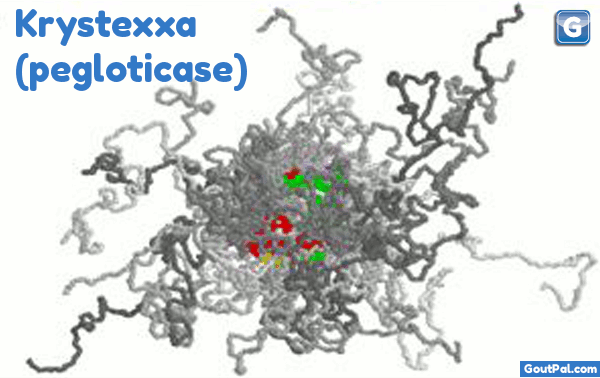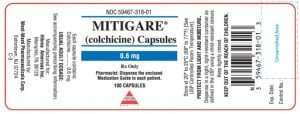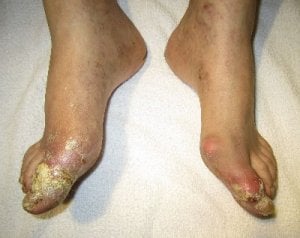Krystexxa (a brand of the generic pegloticase) is a new type of gout treatment, delivered intravenously, which provides a form of uricase.
Unlike other gout medications to avoid gout by lowering uric acid, Krystexxa actually breaks down uric acid to allantoin and other soluble compounds that are easily excreted by the body. As such, it is the fastest way to remove tophi and other uric acid deposits.
Krystexxa Background
This background to Krystexxa is summarized from “Long-term safety of pegloticase in chronic gout refractory to conventional treatment,” which I have reviewed on my Krystexxa Safety page.
The report emphasizes the need for improvements in gout medication. From the 8 million American gout patients, almost a quarter million fail to achieve safe uric acid levels with allopurinol or Uloric (febuxostat).[1] This is because of intolerance to medication, unsuitability due to other health problems, or simple failure to lower uric acid adequately.[2-4]
Safe uric acid lowering is essential. Without it, gout patients risk:
- More gout attacks
- More gouty joints
- Joint destruction and deforming tophi
- Chronic pain
- Impaired mobility
- Poor quality of life
Attempts have been made to reintroduce uricase which has been lost from humans during evolution. Unfortunately, our immune systems see uricase as an invader and develop antibodies against it, reducing its effectiveness.
To counteract the immune system, uricase has been combined with genetically altered ethylene glycol. This medication was initially named PEG-uricase, then registered with the generic name, pegloticase. Pegloticase was approved in the USA in 2010, and marketed as Krystexxa.[5-7]
Krystexxa is taken intravenously, working directly on uric acid dissolved in the blood to convert it to harmless allantoin. With uric acid reduced well below the crystallization point, 6.8mg/dl, uric acid crystals dissolve. This lowers uric acid deposits in tophi, reducing there size, and generally treating the symptoms of gout.[8-9]
Licensing applications included 2 6-month Randomized Controlled Trials (RCTs) which demonstrated the effectiveness and safety of pegloticase.[8] Pegloticase trials were either every 2 weeks or every 4 weeks, with both doses achieving significant uric acid reduction, but not without problems. Though all gout patients achieved lower uric acid levels, some (labeled non-responders) showed reduced effectiveness after the first dose. Also, Infusion-related Reactions (IRs) caused 10% of 2-weekly, and 13% of 4-weekly to withdraw from the trials.[8]

Krystexxa Dosing
Krystexxa is a highly specialized gout treatment with limited distribution. Approved treatment centers must receive information packs from Savient, the manufacturers of Krystexxa. Doctors who prescribe Krystexxa should explain the patients guidelines to the gout patient. This should be done for each course of treatment, as guidelines may change between treatments.
Krystexxa History
Krystexxa Side-effects
Please see the Krystexxa Safety Report
Krystexxa: Next Steps
If you cannot tolerate allopurinol or Uloric (febuxostat), arrange to see a rheumatologist about Krystexxa.
If you have used Krystexxa, please share your experiences in the gout forum.
Leave Krystexxa to browse other Uricase pages.
Krystexxa (pegloticase) Related Topics
Please remember: to find more related pages that are relevant to you, use the search box near the top of every page.
Common Terms: convert, Krystexxa, pegloticase
Other posts that include these terms:
- Krystexxa Safety
- Gout Medications To Avoid Gout By Lower Uric Acid
- Gout Treatment, Cures, Remedies & Relief
- Best Tophi Picture shows greatest Tophi Treatment
- Uric Acid Calculator from Safe to Dangerous
- Uricase for Fast Uric Acid Control
- Uric Acid: Step-by-Step Understanding
Krystexxa (pegloticase) References
- Zhu Y, Pandya BJ, Choi HK. Prevalence of gout and hyperuricemia in the US general population: the National Health and Nutrition Examination Survey 2007–2008. Arthritis Rheum 2011;63:3136–41.
- Edwards NL. Treatment-failure gout: a moving target (editorial). Arthritis Rheum 2008;58:2587–90. Treatment Failure Gout
- Brook RA, Forsythe A, Smeeding JE, et al. Chronic gout: epidemiology, disease progression, treatment and disease burden. Curr Med Res Opin 2010;26:2813–21.
- Doghramji PP, Edwards NL, McTigue J. Managing gout in the primary care setting: what you and your patients need to know. Am J Med 2010;123:S2.
- Sherman MR, Saifer MG, Perez-Ruiz F. PEG-uricase in the management of treatment-resistant gout and hyperuricemia. Adv Drug Deliv Rev 2008;60:59–68.
- Krystexxa® (pegloticase) Injection, for intravenous infusion. Prescribing information. East Brunswick, NJ: Savient Pharmaceuticals, 2010.
- Schlesinger N, Yasothan U, Kirkpatrick P. Pegloticase. Nat Rev Drug Discov 2011;10:17–18.
- Sundy JS, Baraf HS, Yood RA, et al. Efficacy and tolerability of pegloticase for the treatment of chronic gout in patients refractory to conventional treatment. JAMA 2011;306:711–20.
Please give your feedback
Did this page help you? If yes, please consider a small donation. Your donations help keep GoutPal's gout support services free for everyone.
If not, please tell me how I can improve it to help you more.
- YouTube
- The gout forums.









